torque MERCEDES-BENZ GL 2016 Owners Manual
[x] Cancel search | Manufacturer: MERCEDES-BENZ, Model Year: 2016, Model line: GL, Model: MERCEDES-BENZ GL 2016Pages: 462, PDF Size: 12.66 MB
Page 25 of 462
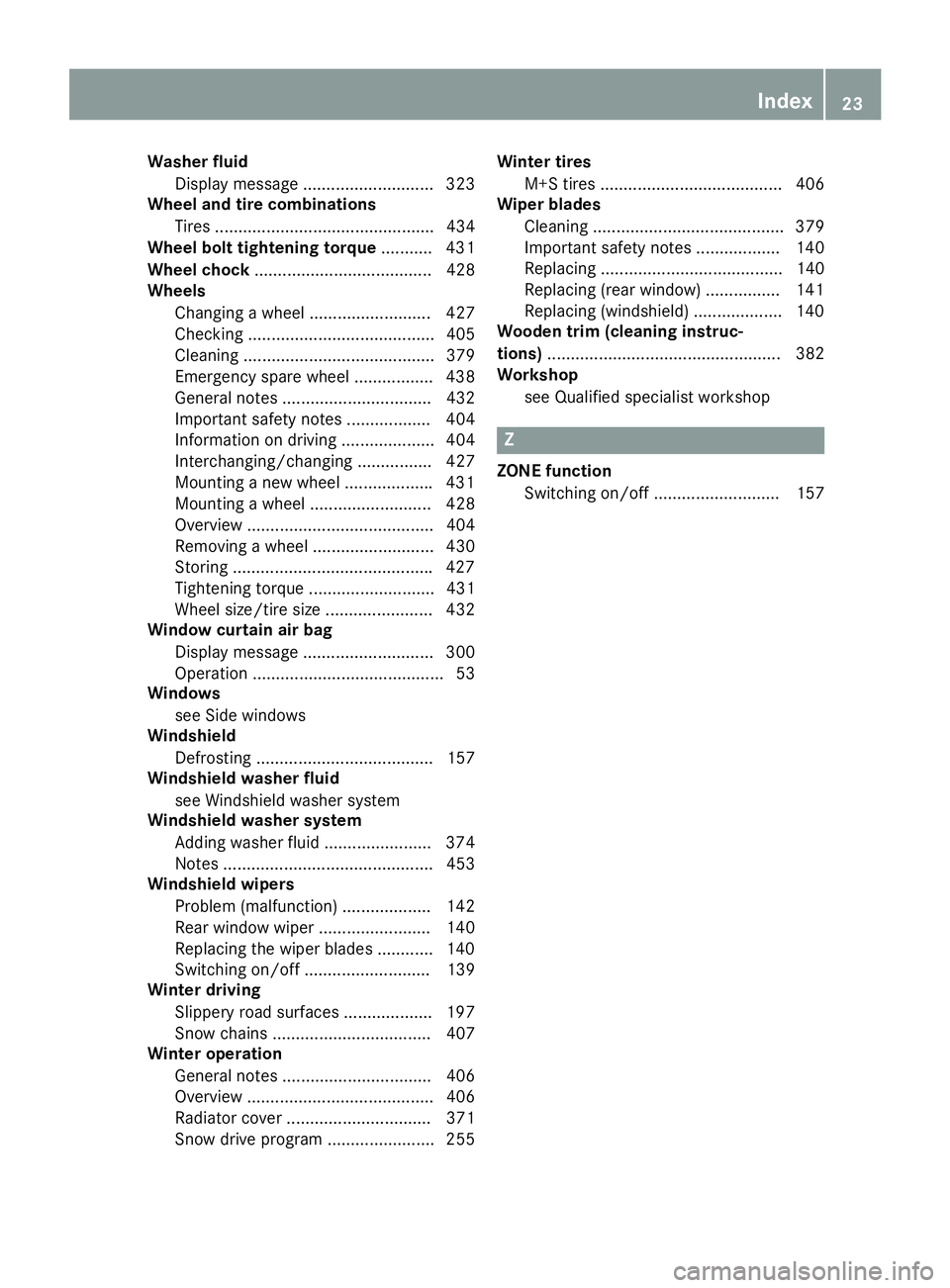
Washer fluid
Display message ............................ 323
Wheel and tire combinations
Tires ............................................... 434
Wheel bolt tightening torque ........... 431
Wheel chock ...................................... 428
Wheels
Changing a wheel .......................... 427
Checking ........................................ 405
Cleaning ......................................... 379
Emergency spare wheel ................. 438
General notes ................................ 432
Important safety notes .................. 404
Information on driving .................... 404
Interchanging/changing ................ 427
Mounting a new wheel .................. .4 31
Mounting a wheel .......................... 428
Overview ........................................ 404
Removing a wheel .......................... 430
Storing .......................................... .4 27
Tightening torque ........................... 431
Wheel size/tire size ....................... 432
Window curtain air bag
Display message ............................ 300
Operation ......................................... 53
Windows
see Side windows
Windshield
Defrosting ...................................... 157
Windshield washer fluid
see Windshield washer system
Windshield washer system
Adding washer fluid ....................... 374
Notes ............................................. 453
Windshield wipers
Problem (malfunction) ................... 142
Rear window wiper ........................ 140
Replacing the wiper blades ............ 140
Switching on/off ........................... 139
Winter driving
Slippery road surfaces ................... 197
Snow chains .................................. 407
Winter operation
General notes ................................ 406
Overview ........................................ 406
Radiator cover ............................... 371
Snow drive program ....................... 255 Winter tires
M+S tires ....................................... 406
Wiper blades
Cleaning .............. ........................... 379
Important safe ty
notes .................. 140
Replacing ....................................... 140
Replacing (rear window) ................ 141
Replacing (windshield) ................... 140
Wooden trim (cleaning instruc-
tions) .................................................. 382
Workshop
see Qualified specialist workshop
Z ZONE function
Switching on/off ........................... 157 Index 23
Page 75 of 462
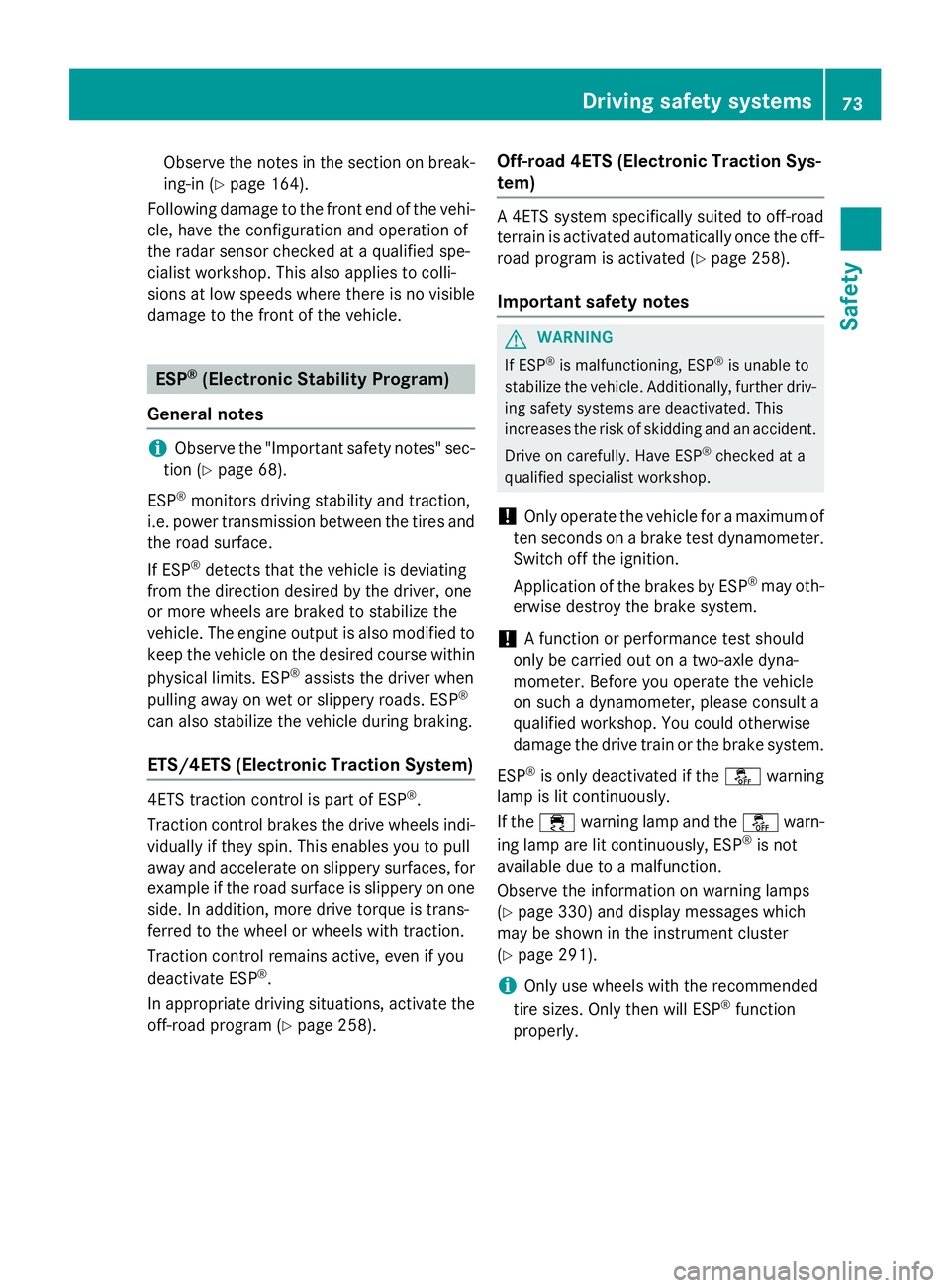
Observe the notes in the section on break-
ing-in ( Y
page 164).
Following damage to the front end of the vehi-
cle, have the configuration and operation of
the radar sensor checked at a qualified spe-
cialist workshop. This also applies to colli-
sions at low speeds where there is no visible
damage to the front of the vehicle.
ESP ®
(Electronic Stability Program)
General notes
i Observe the "Important safety notes" sec-
tion ( Y
page 68).
ESP ®
monitors driving stability and traction,
i.e. power transmission between the tires and
the road surface.
If ESP ®
detects that the vehicle is deviating
from the direction desired by the driver, one
or more wheels are braked to stabilize the
vehicle. The engine output is also modified to
keep the vehicle on the desired course within
physical limits. ESP ®
assists the driver when
pulling away on wet or slippery roads. ESP ®
can also stabilize the vehicle during braking.
ETS/4ETS (Electronic Traction System)
4ETS traction control is part of ESP ®
.
Traction control brakes the drive wheels indi-
vidually if they spin. This enables you to pull
away and accelerate on slippery surfaces, for
example if the road surface is slippery on one
side. In addition, more drive torque is trans-
ferred to the wheel or wheels with traction.
Traction control remains active, even if you
deactivate ESP ®
.
In appropriate driving situations, activate the
off-road program ( Y
page 258). Off-road 4ETS (Electronic Traction Sys-
tem) A 4ETS system specifically suited to off-road
terrain is activated automatically once the off-
road program is activated ( Y
page 258).
Important safety notes
G WARNING
If ESP ®
is malfunctioning, ESP ®
is unable to
stabilize the vehicle. Additionally, further driv-
ing safety systems are deactivated. This
increases the risk of skidding and an accident.
Drive on carefully. Have ESP ®
checked at a
qualified specialist workshop.
! Only operate the vehicle for a maximum of
ten seconds on a brake test dynamometer.
Switch off the ignition.
Application of the brakes by ESP ®
may oth-
erwise destroy the brake system.
! A function or performance test should
only be carried out on a two-axle dyna-
mometer. Before you operate the vehicle
on such a dynamometer, please consult a
qualified workshop. You could otherwise
damage the drive train or the brake system.
ESP ®
is only deactivated if the �
Page 261 of 462
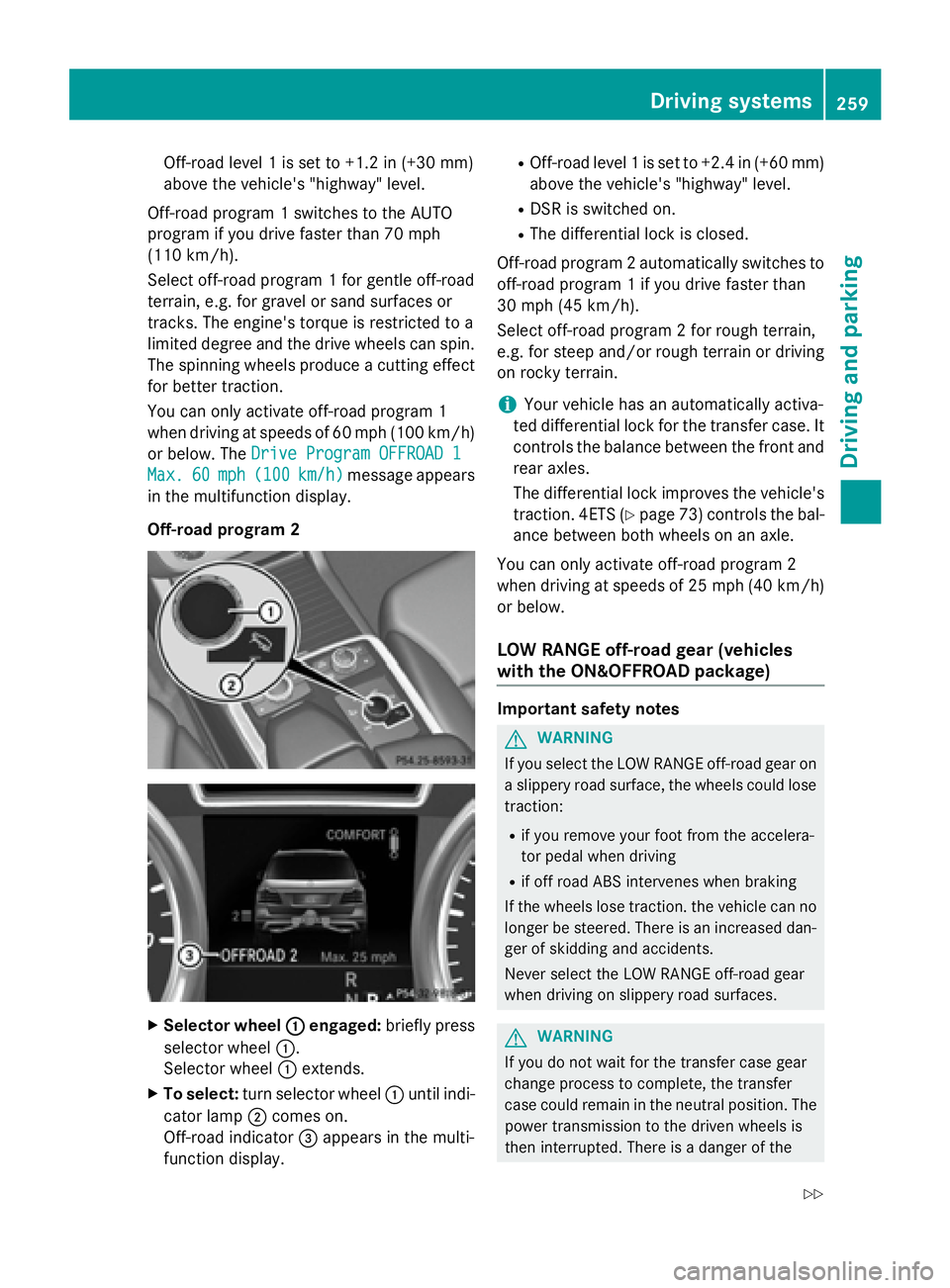
Off-road level 1 is set to +1.2 in (+30 mm)
above the vehicle's "highway" level.
Off-road program 1 switches to the AUTO
program if you drive faster than 70 mph
(110 km/h).
Select off-road program 1 for gentle off-road
terrain, e.g. for gravel or sand surfaces or
tracks. The engine's torque is restricted to a
limited degree and the drive wheels can spin.
The spinning wheels produce a cutting effect
for better traction.
You can only activate off-road program 1
when driving at speeds of 60 mph (100 km/h)
or below. The Drive Program OFFROAD 1
Max. 60 mph ( 100 km/h) message appears
in the multifunction display.
Off-road program 2
X
Selector wheel �C engaged: briefly press
selector wheel �C .
Selector wheel �C extends.X
To select: turn selector wheel �C until indi-
cator lamp �D comes on.
Off-road indicator �
Page 262 of 462
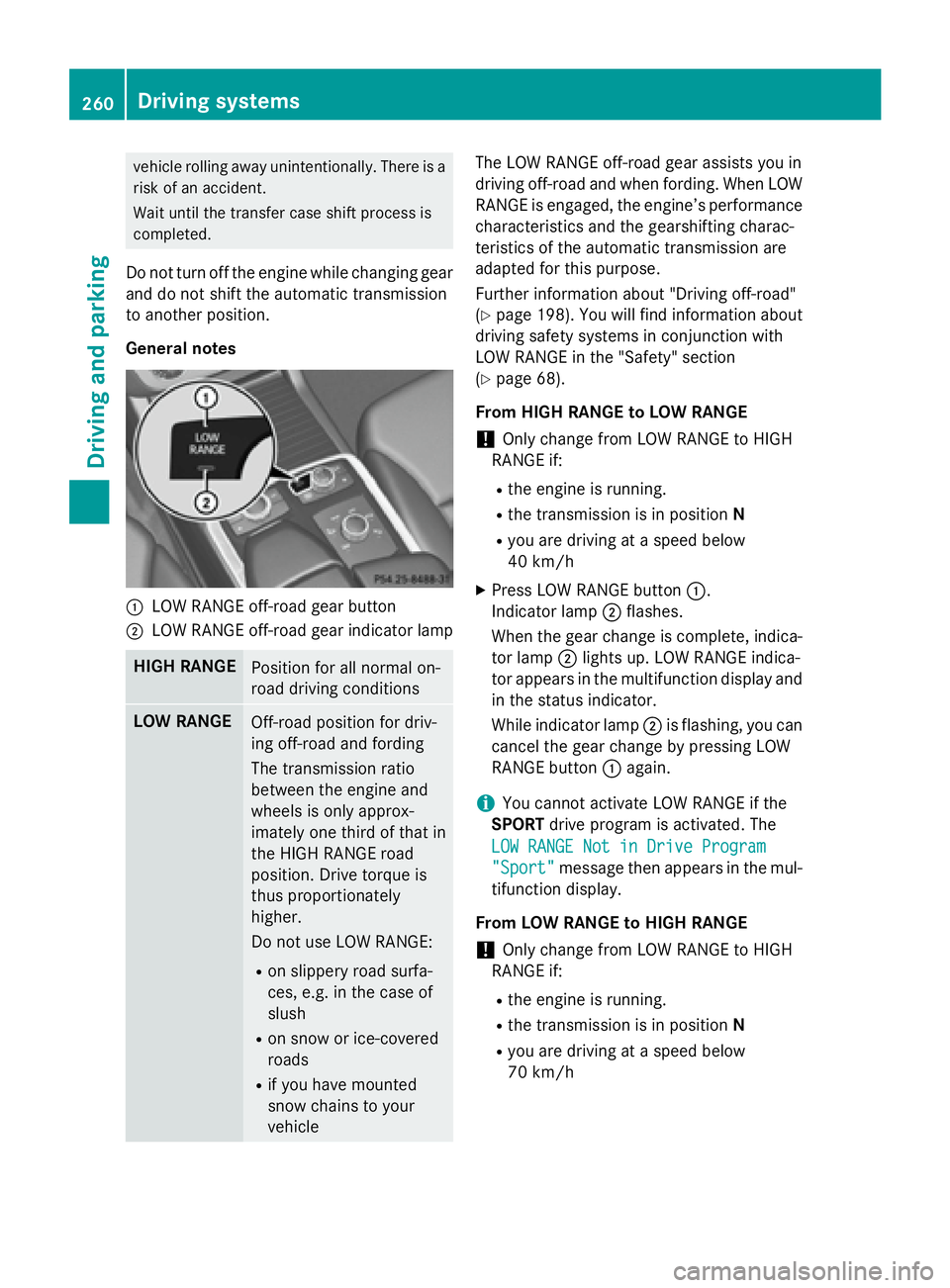
vehicle rolling away unintentionally. There is a
risk of an accident.
Wait until the transfer case shift process is
completed.
Do not turn off the engine while changing gear
and do not shift the automatic transmission
to another position.
General notes
�C
LOW RANGE off-road gear button�D
LOW RANGE off-road gear indicator lamp
HIGH RANGE
Position for all normal on-
road driving conditions
LOW RANGE
Off-road position for driv-
ing off-road and fording
The transmission ratio
between the engine and
wheels is only approx-
imately one third of that in
the HIGH RANGE road
position. Drive torque is
thus proportionately
higher.
Do not use LOW RANGE: R
on slippery road surfa-
ces, e.g. in the case of
slush R
on snow or ice-covered
roads R
if you have mounted
snow chains to your
vehicle The LOW RANGE off-road gear assists you in
driving off-road and when fording. When LOW
RANGE is engaged, the engine’s performance
characteristics and the gearshifting charac-
teristics of the automatic transmission are
adapted for this purpose.
Further information about "Driving off-road"
( Y
page 198). You will find information about
driving safety systems in conjunction with
LOW RANGE in the "Safety" section
( Y
page 68).
From HIGH RANGE to LOW RANGE
! Only change from LOW RANGE to HIGH
RANGE if: R
the engine is running. R
the transmission is in position NR
you are driving at a speed below
40 km/h X
Press LOW RANGE button �C .
Indicator lamp �D flashes.
When the gear change is complete, indica-
tor lamp �D lights up. LOW RANGE indica-
tor appears in the multifunction display and
in the status indicator.
While indicator lamp �D is flashing, you can
cancel the gear change by pressing LOW
RANGE button �C again.
i You cannot activate LOW RANGE if the
SPORT drive program is activated. The
LOW RANGE Not in Drive Program
"Sport" message then appears in the mul-
tifunction display.
From LOW RANGE to HIGH RANGE
! Only change from LOW RANGE to HIGH
RANGE if: R
the engine is running. R
the transmission is in position NR
you are driving at a speed below
70 km/h260
Driving systems
Driving and parking
Page 433 of 462
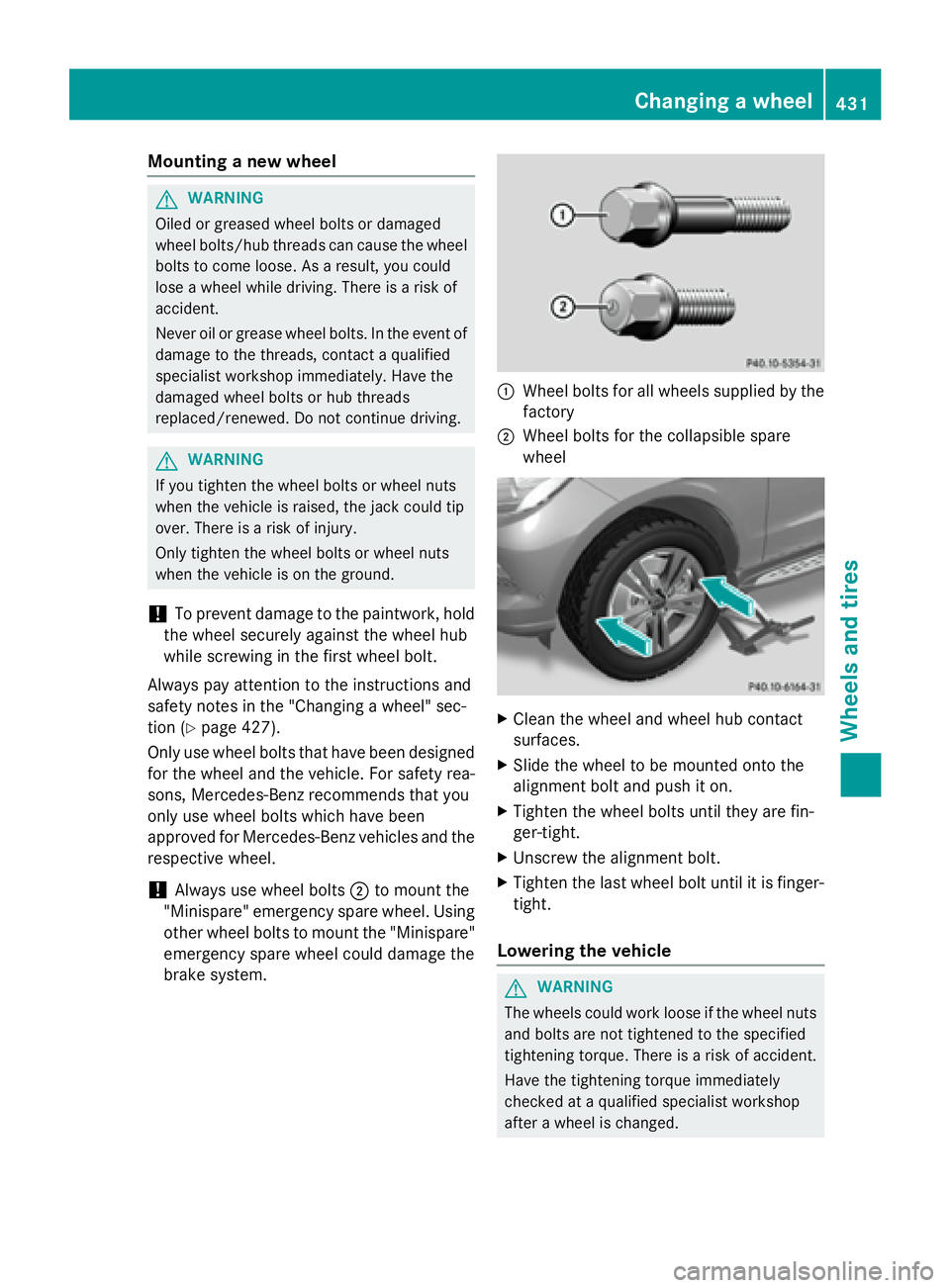
Mounting a new wheel
G WARNING
Oiled or greased wheel bolts or damaged
wheel bolts/hub threads can cause the wheel
bolts to come loose. As a result, you could
lose a wheel while driving. There is a risk of
accident.
Never oil or grease wheel bolts. In the event of
damage to the threads, contact a qualified
specialist workshop immediately. Have the
damaged wheel bolts or hub threads
replaced/renewed. Do not continue driving.
G WARNING
If you tighten the wheel bolts or wheel nuts
when the vehicle is raised, the jack could tip
over. There is a risk of injury.
Only tighten the wheel bolts or wheel nuts
when the vehicle is on the ground.
! To prevent damage to the paintwork, hold
the wheel securely against the wheel hub
while screwing in the first wheel bolt.
Always pay attention to the instructions and
safety notes in the "Changing a wheel" sec-
tion ( Y
page 427).
Only use wheel bolts that have been designed
for the wheel and the vehicle. For safety rea-
sons, Mercedes-Benz recommends that you
only use wheel bolts which have been
approved for Mercedes-Benz vehicles and the
respective wheel.
! Always use wheel bolts �D to mount the
"Minispare" emergency spare wheel. Using
other wheel bolts to mount the "Minispare"
emergency spare wheel could damage the
brake system. �C
Wheel bolts for all wheels supplied by the
factory �D
Wheel bolts for the collapsible spare
wheel
X
Clean the wheel and wheel hub contact
surfaces. X
Slide the wheel to be mounted onto the
alignment bolt and push it on. X
Tighten the wheel bolts until they are fin-
ger-tight. X
Unscrew the alignment bolt. X
Tighten the last wheel bolt until it is finger-
tight.
Lowering the vehicle
G WARNING
The wheels could work loose if the wheel nuts
and bolts are not tightened to the specified
tightening torque. There is a risk of accident.
Have the tightening torque immediately
checked at a qualified specialist workshop
after a wheel is changed.Changing a wheel 431
Wheels and tires Z
Page 459 of 462
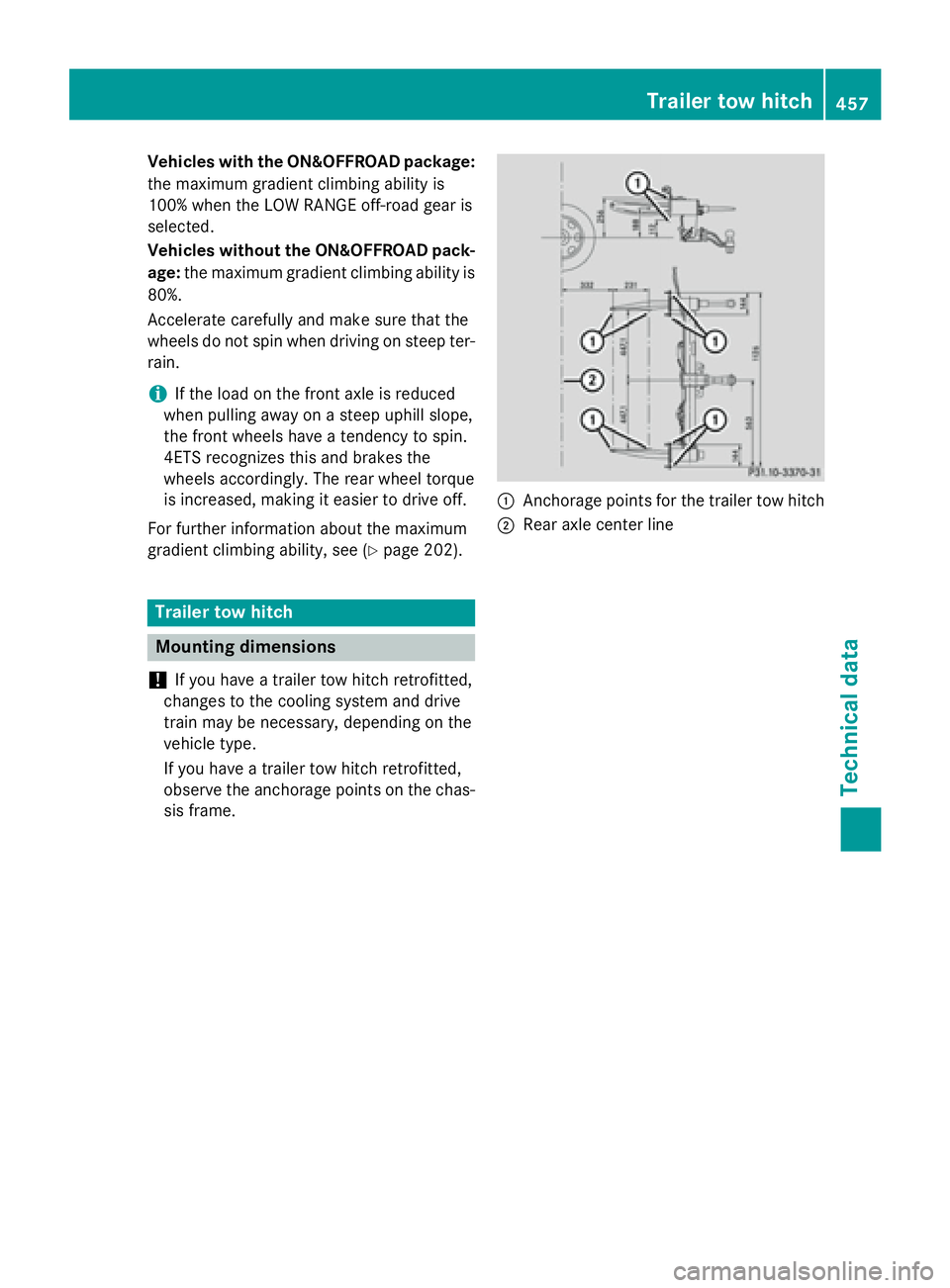
Vehicles with the ON&OFFROAD package:
the maximum gradient climbing ability is
100% when the LOW RANGE off-road gear is
selected.
Vehicles without the ON&OFFROAD pack-
age: the maximum gradient climbing ability is
80%.
Accelerate carefully and make sure that the
wheels do not spin when driving on steep ter-
rain.
i If the load on the front axle is reduced
when pulling away on a steep uphill slope,
the front wheels have a tendency to spin.
4ETS recognizes this and brakes the
wheels accordingly. The rear wheel torque
is increased, making it easier to drive off.
For further information about the maximum
gradient climbing ability, see ( Y
page 202).
Trailer tow hitch
Mounting dimensions
! If you have a trailer tow hitch retrofitted,
changes to the cooling system and drive
train may be necessary, depending on the
vehicle type.
If you have a trailer tow hitch retrofitted,
observe the anchorage points on the chas-
sis frame. �C
Anchorage points for the trailer tow hitch �D
Rear axle center lineTrailer tow hitch 457
Technical data Z